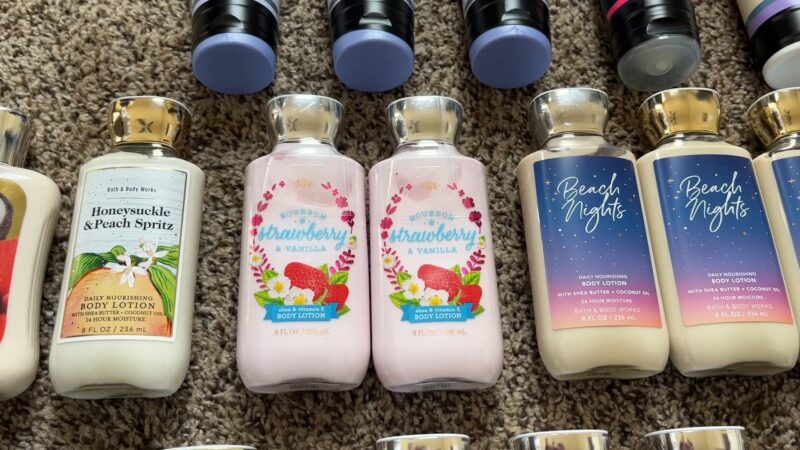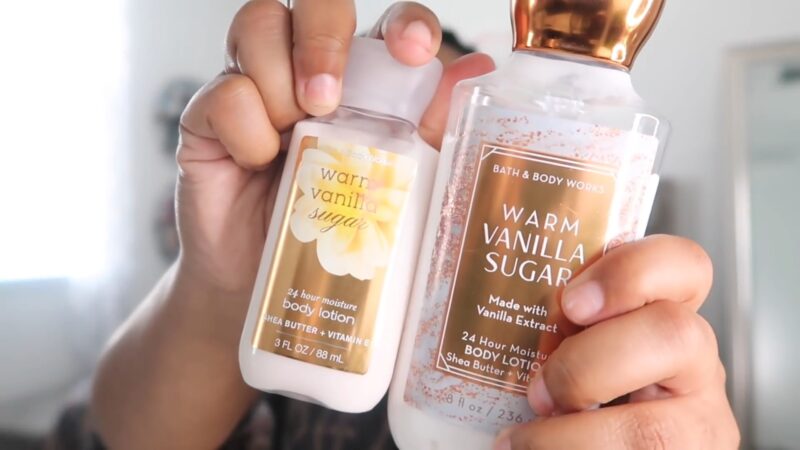It’s essential to know whether does bath and body works lotion expire whether it’s time to toss it out.
Yes, Bath and Body Works lotions do expire, typically within 2 to 3 years. To keep your lotion in the best condition, store it in a cool, dry place away from direct sunlight and extreme temperatures.
Different ingredients in these lotions, such as glycerin and aloe vera, have their shelf lives and contribute to the product’s overall effectiveness.
While the lotions don’t usually have an expiration date printed on the packaging, a batch code system is used to determine the age of the product.
Shelf Life of Skin Care Products
- Expiration Dates: Some products display an expiration date, typically formatted as a month and year. This date indicates the time by which the product should be used to ensure optimal effectiveness.
- PAO Symbol: A common indicator found on skin care products is the PAO (Period After Opening) symbol. It looks like an open jar with a number (e.g., 12M). This number specifies the number of months the product remains effective after being opened.
- Storage Conditions: Proper storage is crucial. Keep skin care items in a cool, dry place away from direct sunlight and extreme temperatures. Ensure that the caps are tightly sealed to prevent air from degrading the product.
Common Shelf Life:
- Cleansers and Toners: Approximately 6-12 months.
- Moisturizers: Usually last between 12-24 months.
- Sunscreens: Typically effective for about 1 year post-opening.
Bath and Body Works Lotion Composition

Bath and Body Works lotions are known for their rich and fragrant formulas. These lotions are a blend of numerous ingredients designed to provide both hydration and a pleasant scent.
Key components often found in Bath and Body Works lotions include:
- Water: Helps blend ingredients together smoothly.
- Glycerin: Maintains skin moisture and softness.
- Fragrance: Provides the characteristic scent.
Additionally, many of these lotions contain:
- Citric Acid: Adds a slight tang and helps maintain pH balance.
- Sodium Lauryl Sulfate: Contributes a foamy texture.
- Cocamidopropyl Betaine: Gently cleanses the skin.
For added skin benefits, you might find:
- Aloe Barbadensis Leaf Extract: Soothes and calms irritated skin
Indicators of Lotion Expiration

Changes in Texture
Expired lotions often exhibit changes in texture. They may become thicker or thinner than they originally were. This alteration can compromise the lotion’s ability to moisturize effectively. Users may notice that the product no longer spreads evenly on the skin or feels grainy when applied. Keeping an eye on these texture changes is essential to ensure the lotion’s continued efficacy.
Color Alterations
A clear sign of an expired lotion is a change in color. Bath and Body Works lotions typically maintain consistent coloring. However, with time, they can develop a yellowish or brownish hue. This indicates that the ingredients are breaking down or reacting with one another. Any deviation from the original color should be taken as a warning sign that the product is no longer suitable for use.
Separation of Ingredients
Separation of ingredients is another telltale sign of expiration. When lotions expire, their ingredients can split, with oils rising to the top and water settling at the bottom. This is often due to the breakdown of emulsifiers that keep the product mixed. If you notice this kind of separation, it is best to discard the lotion as it signals a loss of stability and effectiveness.
Altered Scent
The scent of lotions can also change as they age. Bath and Body Works lotions are known for their strong fragrances, but expired products may smell off or sour. This scent alteration occurs due to the degradation of fragrance compounds and other ingredients. If the lotion no longer smells like it originally did, it is a clear indicator that it has expired and should not be used.
Proper Storage for Longevity
Proper storage practices can significantly extend the shelf life of Bath and Body Works lotions. Follow these guidelines to ensure your lotions remain effective and fresh.
- Cool, Dry Place: Store your lotions in a cool, dry place. Avoid areas with high humidity or temperature fluctuations, such as bathrooms.
- Avoid Direct Sunlight: Keep lotions away from direct sunlight. Exposure to sunlight can degrade the ingredients and lead to premature expiration.
- Sealed Containers: Ensure the caps are tightly sealed. This prevents air from entering the container, which can cause the lotion to dry out or oxidize.
- Use Refrigeration: For added longevity, you can store lotions in the refrigerator. This helps maintain their consistency and effectiveness.
- Proper Usage: Always use clean hands or a pump to dispense lotion. This reduces the risk of contamination, which can affect the lotion’s shelf life.
- Batch Codes: Bath and Body Works uses batch codes instead of expiration dates. Familiarize yourself with how to read these codes to determine the age of the product.
Risks of Using Expired Lotions

Using expired lotions can have several negative impacts on the skin and overall health.
Expired lotions may lose their effectiveness. Ingredients like moisturizers and vitamins can degrade over time, reducing their ability to hydrate and nourish the skin.
- Bacterial Growth: When preservatives break down, lotions can become a breeding ground for bacteria and mold. This can lead to infections, especially on broken or sensitive skin.
- Unpleasant Odor: Expired lotions often develop an off smell, which can be unpleasant and signal that the product has gone bad.
- Changes in Texture: Expired lotions might separate or become watery, making them difficult to apply evenly on the skin and make your skin look like it is dyed.
List of Risks:
- Decreased effectiveness
- Potential for bacterial contamination
- Risk of skin irritation or allergic reactions
- Unpleasant odor
- Altered texture
Maximizing Shelf Life
- Store in a Cool, Dry Place
- Seal Tightly
- Avoid Humidity

